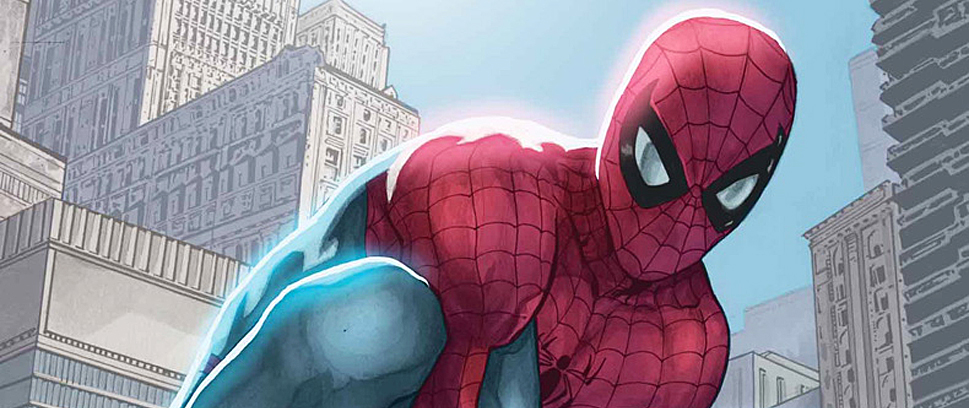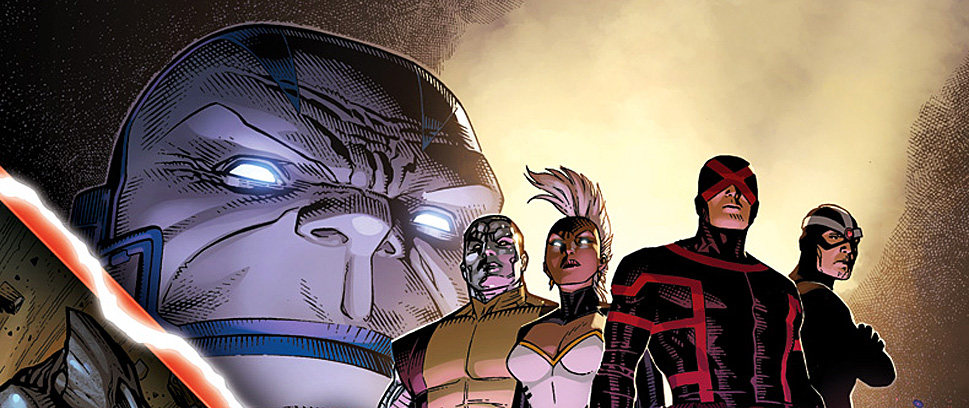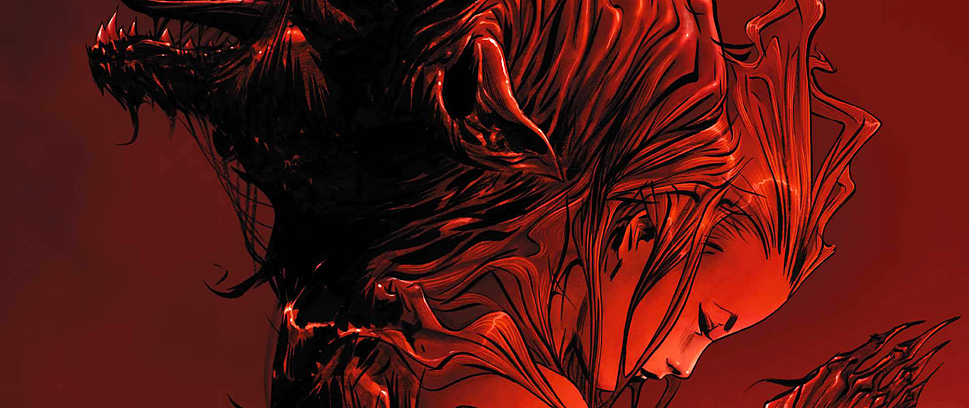
Last Week’s Comics 12/10/2014
Wolf Moon #1
(Vertigo – writer: Cullen Bunn; artist: Jeremy Haun)
Of all the creatures out there, the werewolf is by far my most favorite. Of all the things I fear in the world, the werewolf is number one and if any of my dreams can be classified as nightmares, they usually involve men turning into giant, flesh eating wolves.
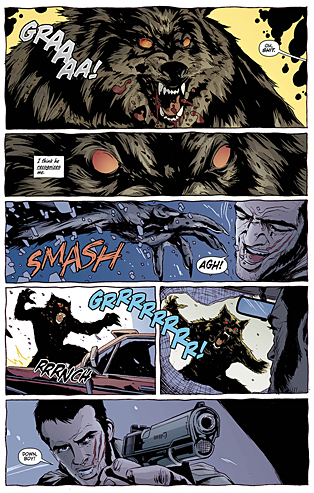 With that in mind, the werewolf genre is a tricky one about which to write. Authors usually stick to the same basic tenets: man turns into giant wolf during the full moon, man eats people, man is hunted by familiar adversary, man is shot with silver bullet and thanks said shooter for freeing him. So when an author comes up with a new take on a familiar story, and one that’s both unique and intriguing, you have to respect him for it, and urge others to do the same.
With that in mind, the werewolf genre is a tricky one about which to write. Authors usually stick to the same basic tenets: man turns into giant wolf during the full moon, man eats people, man is hunted by familiar adversary, man is shot with silver bullet and thanks said shooter for freeing him. So when an author comes up with a new take on a familiar story, and one that’s both unique and intriguing, you have to respect him for it, and urge others to do the same.
So I’ll begin my review with a very simple statement: read Wolf Moon.
The comic for the most part is pretty conventional. Wolf Moon has its own Van Helsing-type character in its lead, Dillon Chase, a mysterious man who’s been tracking the beast for a long while due to a personal vendetta. We know from his brooding narrative (and wickedly scarred face) that he’s encountered this creature before, but his quest is a bit more than just putting it down to save a man’s life. What we learn but the end of the issue is that the werewolf is not what it seems, and the reveal is too good to spoil here. Just go read the book already so we can have a proper chat.
Jeremy Haun has a gritty style, not unlike a mixture of Scalped‘s R.M. Guèra and Walking Dead‘s Charlie Adlard. It’s gruesome and messy, and it sells the gore of the comic. When the beast attacks, Haun wastes no time, and the quick movement of the werewolf between panels shows just how quick it is. So where one might look and see a lapse of smooth pacing, I see an artist who wants to sell not only the ferocity of the beast, but its speed as well. As Chase says at one point, “The herd scatters. Consumed by fear. Worked into a frenzy by the knowledge that an apex predator is in their midst.” No better term describes this werewolf, and if you’re already a fan of the creature, you’ll love what Bunn and Haun have done to it.
If you can’t tell, I loved Wolf Moon. Yes, it still uses the same rules and conventions we’ve come to know with werewolves, but it also makes an original stamp on the creature, and it does so in a way that has me clambering for more. Bunn deserves credit for his creativity, and Haun deserves credit for his tonally perfect artistic style.
Even though it terrifies me, I’m definitely up for more Wolf Moon.
Besides, everyone loves a good scare once in a while.
———
Secret Six #1
 (DC – writer: Gail Simone; artist: Ken Lashley)
(DC – writer: Gail Simone; artist: Ken Lashley)
While comics are chock full of the group of good guys – the Justice Leagues and Avengers – they’re not as packed with groups of bad guys. Usually because bad guys don’t operate together, or when they do, their own egos lead them to destruction. So Gail Simone is returning to the world of the anti-hero with her New 52 Secret Six, a comic that changes its lineup and adjusts its characters for the new universe.
The result is a comic that is paint by numbers and not wholly original, which is especially disappointing given that it’s written by one of comics’ premiere writers. Instead, Secret Six is a mashup of flat characters, poor pacing and uneven art. Very little of this story has me wanting more.
The comic focuses mainly on Catman, but makes sure to do the rounds and introduce Big Shot, Porcelain, the Ventriloquist, Strix and Alice Black. But everything about the comic is perfunctory and methodical, like Simone had a checklist of things to accomplish. Plus, there’s the major mystery of the story, and while that’s the most interesting part of Secret Six, it never gets enough time to develop. Instead, it’s thrown around in the background, playing second fiddle to poor character development.
Simone’s character introductions are quick and systematic, like she had to make sure that every character was introduced. This makes the story secondary to the characters, but unfortunately none of the characters has any likable traits. Yes, we’re dealing with villains, but we should still be interested in seeing what they can do. At no point did I really care about these people. They’re all egocentric and unstable. Why would I want to follow any of their stories?
Furthermore, Ken Lashley’s art is, for lack of a better word, messy. The beginning of the comic is excessive with the amount of debris Lashley puts into each panel. One in particular has Catman destroying a phone booth, but it looks like a car crash. There’s just too much debris in the panel to make the picture clear. The second part of the issue is inconsistent with the first, but at least it’s a bit less erratic. However, the imagery loses something towards the end, and I can’t help but wonder if Lashley was in a rush to complete the comic because the art in the second half is very different from the art that begins the comic. Granted, the final image of the comic is pretty stellar, but that’s not enough to save the issue.
I like the mystery of Secret Six; I just don’t care for much else. I’d be willing to come back for more next month, but I’d hope to be wowed by what I saw because Secret Six #1 is not a solid debut. It’s a surprising step away from what we know Gail Simone is capable of, and it lacks her usual panache. I only hope that number two is a step in the right direction, and a major diversion from this introductory issue.
———
The Humans #2
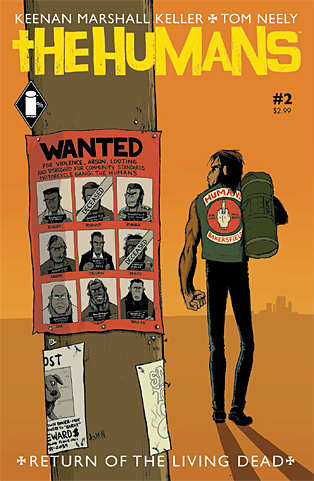 (Image – writer: Keenan Marshall Keller; artist: Tom Neely)
(Image – writer: Keenan Marshall Keller; artist: Tom Neely)
I bought The Humans #1 on a whim last month, and it was the best comic book decision I’ve made in a long time. I counted down the days until issue #2 came out, and that was before I realized artist Tom Neely was behind the hilarious Glenn Danzig/Henry Rollins domestic love story, Henry & Glenn Forever!
I asked the proprietor of my local comics shop if he read The Humans (as I can’t get a grip on what he reads regularly), telling him what a blast it was to read. He told me that he hadn’t yet, but preemptively ordered extra copies of issue #2, as he’s gotten some upset feedback from fellow comics retailers about the content of the issue and was expecting this controversy to increase interest.
As shocking as issue #1 was, The Humans has more to offer than just drinking, fighting and fucking. There will be those who “get it,” who can pick up on the irony, the play on stereotypes and the subversiveness, and those who don’t. Just because something depicts sex doesn’t mean it is inherently sexist. Just because something depicts violence doesn’t mean it is of itself violent. The real blood and guts and feeling is in the depth of The Human’s ensemble cast.
The mysterious Johnny, thought a casualty of the Vietnam War, returns to Bakersfield. Locals think he’s the same punk with a chip on his shoulder, but his brothers-on-bikes know something’s not right, that the war broke Johnny. Johnny’s rage and flashbacks are certain indicators of post-traumatic stress disorder, a condition that certainly existed (although under a different name, “gross stress reaction”) in 1970 but was not widely spoken about.
Issue #2 is paced more slowly than the first, but serves to emphasize the heavy moments (double splash pages are devoted to both Johnny’s military training flashback and his psychedelic catharsis.) Characters are fleshed out (no pun intended), setting up depth to a book that I hope sticks around for a long time.
Writer Keenan Marshall Keller, artist Tom Neely and colorist Kristina Collantes gel as a team. The art, color and writing are all of the same tone. My favorite touches are the yellow tinges to the pages and Neely’s hand-lettered dialogue and sound effects.
Issue #2 ends similarly to #1 with a letters page and links to download songs to the growing Humans soundtrack. The songs enhance the reading experience, and are a nice touch. The creators of this book want their readers to dig what they dig, and support fellow outsider musicians and artists. So if you’re going to jump on this ride, do so with both feet and don’t look back!
———
Justice League 3000 #12
 (DC – writer: Keith Giffen, J.M. DeMatteis; artist: Howard Porter)
(DC – writer: Keith Giffen, J.M. DeMatteis; artist: Howard Porter)
I haven’t been able to get on board with the New 52. I’m sure anyone who follows this feature has noticed my lack of DC coverage. It’s nothing against the company, I quite enjoy DC Comics like Fables and Sandman: Overture. Multiversity is off-the-wall Grant Morrison, which I always enjoy. Beyond a random one-off issue or Batman ’66 , though, nothing much has been happening between me and the Distinguished Competition. So I guess Justice League 3000 #12 was meant for readers like me.
In this issue we see Blue Beetle and Booster Gold, Team Blue & Gold, back together and fighting crime in a future time. Or more like them being up to their usual scheming and tomfoolery in a future time. I always enjoy the character work by Giffen and DeMatteis, their writing on the Justice League issues of the late ’80s and early ’90s ranks as some of my favorite comic books of all time. Even the I Can’t Believe It’s Not the Justice League miniseries, Defenders miniseries and one-off issues they’ve done in the last few years have been wonderful. So why is it that something felt off about this issue?
I never forgave the decision to use Blue Beetle as a martyr in Countdown to Infinite Crisis. It’s a watermark where I felt the tone and quality of the main DC comics universe were heading into a certain dark and violent aesthetic that they’re still wallowing in, for the most part. Now it seems like DC is finally using the New 52 loophole to bring Ted Kord back. Having been cryogenically frozen in our time, he and Booster Gold (aka Michael Jon Carter) are found and unfrozen in the 31st century.
These are the pre-New 52 Booster and Beetle, who make references to many of their fun adventures in the past, but who also seem to be making a lot of these references to catch new readers up on who they are. DeMatteis is a whiz at writing dialogue for these guys, so reading them banter is wonderful. I just don’t know if it fits in this title, or potentially fits in the crazy bleak cyber-future of the 31st century. There’s a weird sub-plot involving a fat guy who has taken over Beetle’s old lair and is even wearing one of his costumes, who is trying to kill Booster and Beetle because there can only be one Blue Beetle I guess?
I don’t know much about the Justice League 3000 crew. They only appear in three pages, and two of those are a splash of Wonder Woman in action. While it doesn’t bother me, I wonder what the reaction of fans and readers of this book will be, since it didn’t really give me any background on the main characters in this series.
Howard Porter’s art is great, a nice compliment to DeMatteis and Giffen’s writing that puts him in rare company with the wonderful art of Kevin Maguire, still the greatest Giffen/DeMatteis artistic collaborator. There are wonderful facial expressions throughout the issue, and Porter creates a dense, dangerous and crazy futuristic city that Booster and Beetle walk through as if they’re blindfolded walking through a minefield.
While I have some gripes about this issue, I will be picking up #13 just to see where the story is going, so I guess score one for New 52 DC. I’m hoping that Booster and Beetle are permanent additions, and not just a scheme to boost sales by bringing in curmudgeons like me. Even more so I’m hoping that we can get a spinoff for Giffen and DeMatteis to work their magic on with Team Blue & Gold and their misadventures through time.
———
Hellboy and the B.P.R.D. 1952 #1
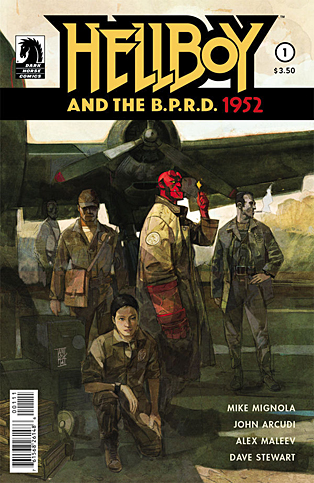 (Dark Horse – writer: Mike Mignola and John Arcudi; artist: Alex Maleev)
(Dark Horse – writer: Mike Mignola and John Arcudi; artist: Alex Maleev)
One of these days I am going to catch up with the Mignolaverse. With the exception of Hellboy in Hell, I’m way behind on the epic ongoing storyline with the past and current B.P.R.D. books, Abe Sapien, Lobster Johnson and related comics. Ideally, I want to read all of these in one massive sitting, enjoying the story as a whole and not just in monthly installments. That said, I will read Hellboy and the B.P.R.D. whenever a new issue comes out each month. This is the Hellboy serial that I’ve been eagerly awaiting since we were first given a hint that he’s been having adventures since the early 1950s. Presented in this miniseries will be Hellboy’s first mission with the B.P.R.D. back in 1952.
One of the many smart decisions that Mike Mignola made when he was setting up the Hellboy universe was giving Hellboy decades of unseen adventures, allowing for that space in time to eventually be covered later on. To be honest, things have become so bleak in the regular B.P.R.D. comics that seeing the early iteration of the team go on a seemingly simple supernatural adventure in Brazil feels like a reassuring and familiar breath of fresh air. The case seems simple for now at least, although things are already looking sinister in this village that’s afraid of the dark, and of the sinister castle looming over it.
Known more for his artistic work with Brian Michael Bendis over at Marvel, Alex Maleev handles his artistic chores with aplomb in this issue. It’s always interesting when artists working on a Mike Mignola-created comic incorporate certain Mignola cues in their own artistic interpretation. The use of shadows and color, the linework, certain intricate details on an artifact or in the background are all things I detected and appreciated in this issue. While Hellboy is essentially an adult at this point, Maleev draws him so that he looks slightly underbaked, or not quite ready for the many adventures that are ahead of him.
So far I’m loving this series right out of the gate. Telling Hellboy’s early mission stories now, knowing what we know about where things are going to go in his life, is a smart move that makes for a fully realized narrative. In one sequence Professor Broom stares out of the window and sees the city on fire with full-on demon Hellboy/Anung Un Rama looming over it. This is a sign of things to come and ties in nicely with the plots currently happening over in the other Mignolaverse comics.
There really isn’t much more for me to say. If you’re a fan of Hellboy, you should definitely give this new series a chance. It’s been a while since we’ve seen the red guy tackling supernatural monster adventures on the mortal plain, and at this point the plan for Mignola and his gang to publish a miniseries each year dedicated to each of Hellboy’s initial years on the B.P.R.D. Think of this as Year One for Hellboy, where he makes up for his inexperience with a cocksure attitude, wisecracks and smoking. Not to mention the equalizer that is his right hand of doom. If that doesn’t win over you, the Hellboy fan, then I don’t know what will.

